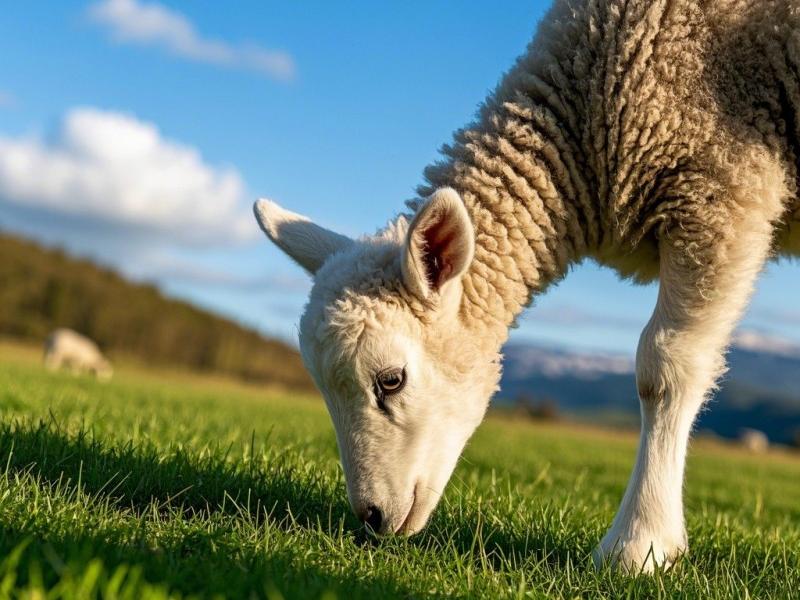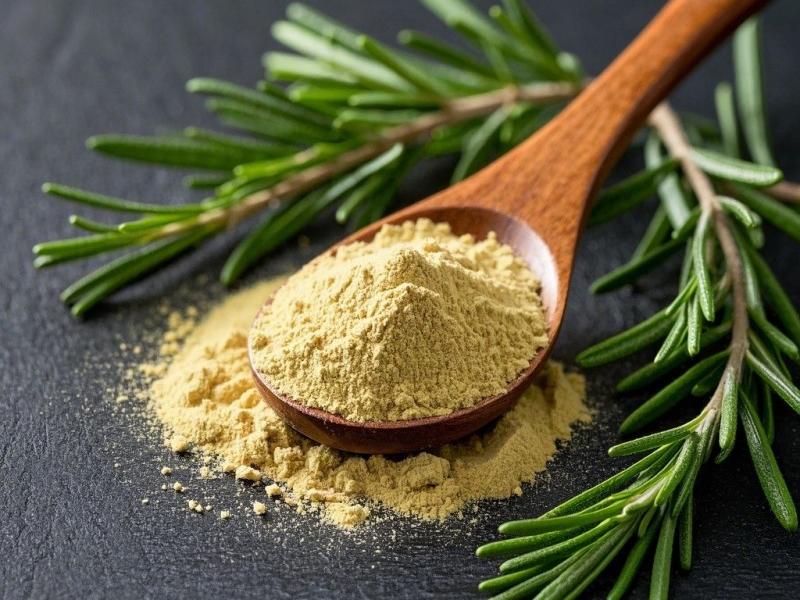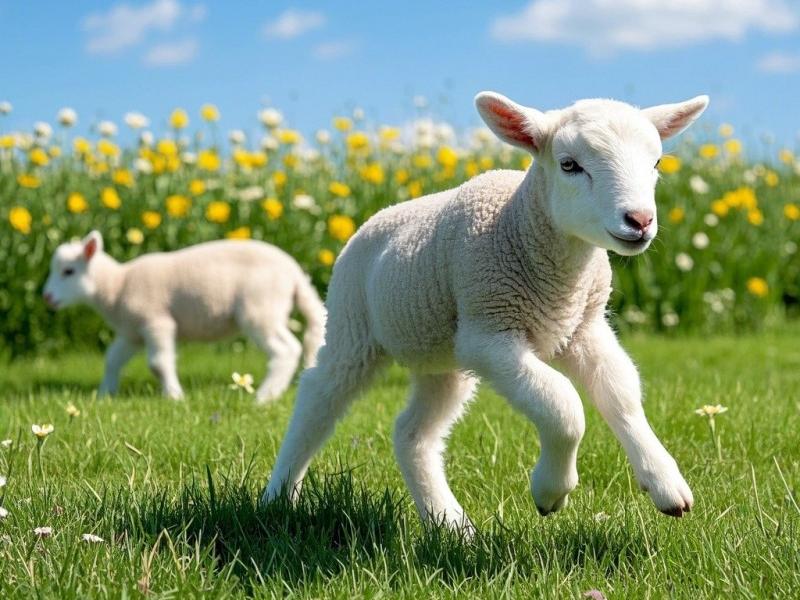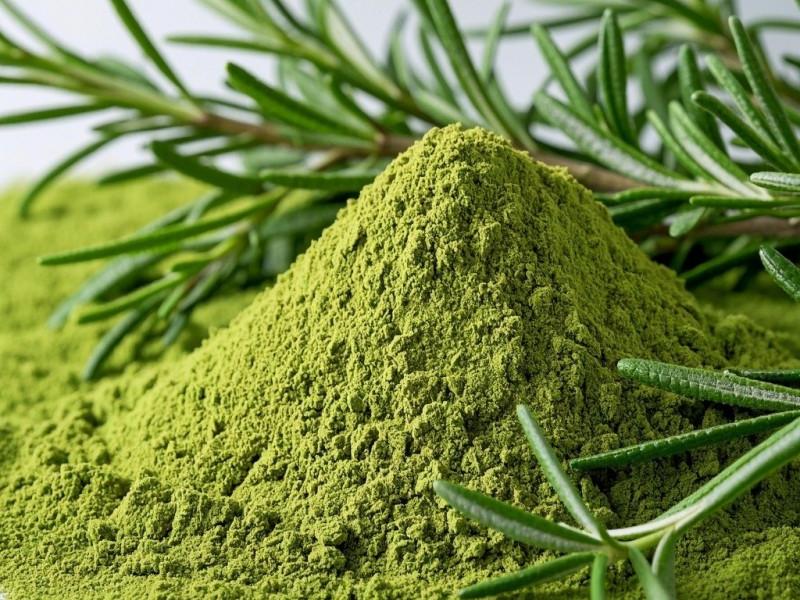What Is the Use of Rosemary in Telugu in Animal Feeding?
Rosemary (Rosmarinus officinalis) is a shrub in the genus Rosmarinus of the family Lamiaceae. It prefers warm climates and is native to Europe and the northern Mediterranean coast of Africa. It is now mainly cultivated in most parts of southern China and Shandong Province[1]. Rosemary has a sedative effect, refreshes the mind in Telugu, strengthens the heart, promotes metabolism and blood circulation in the peripheral blood vessels, strengthens the liver, and lowers blood sugar. It is also effective against indigestion and stomach pain, and is often used to treat insomnia, palpitations, headaches, indigestion and other conditions [2-3].
Essential oil is an antioxidant with strong antioxidant properties. Studies have shown that rosemary essential oil can be extracted from the flowers and leaves of rosemary[4]. Rosemary extract has bactericidal, antibacterial and antioxidant properties[5-6]. In recent years, due to the implementation of the anti-feed policy, rosemary active ingredients have been widely used in animal production as a safe, efficient, low-residue, non-resistant and green feed additive[7-8]. Related studies have found that rosemary active ingredients can improve the immunity and antioxidant properties of animal bodies, regulate blood lipid metabolism, promote body health, and thus promote animal growth and improve the quality of livestock products [9-10]. Therefore, this article reviews the extraction process, physical and chemical properties, biological functions, and application research of rosemary active ingredients in animal production, providing a reference for the efficient use of rosemary active ingredients in animal production.
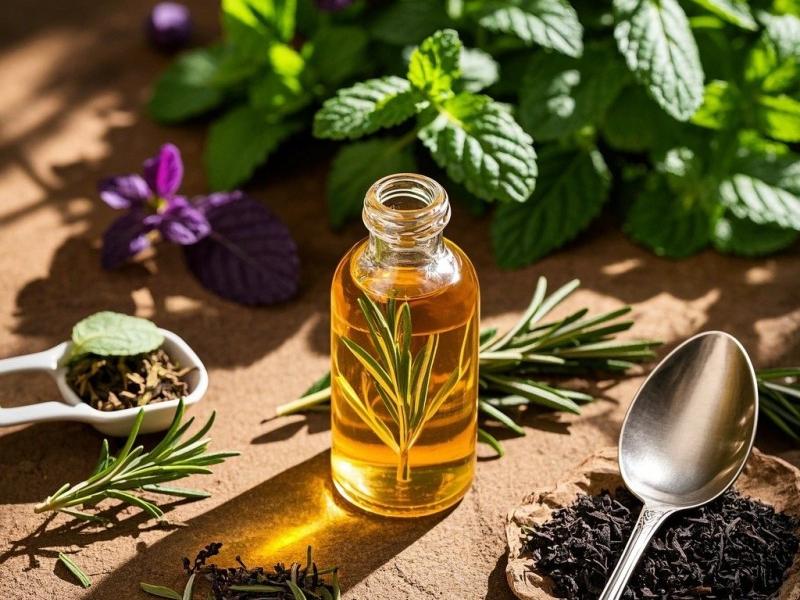
1 Rosemary active ingredients
Rosemary active ingredients can be divided into non-volatile substances and volatile substances. Among them, non-volatile substances mainly include flavonoids, phenolic acids and polyterpenes; volatile substances are mainly rosemary essential oils (monoterpenes and sesquiterpenes) [11].
1.1 Flavonoids
Rosemary extract contains about 0.16% flavonoids, the main components of which are quercetin, naringenin and luteolin. More than 40 types of flavonoids have been found in rosemary [12]. Flavonoids are mostly crystalline solids, a few are amorphous powders, and are easily soluble in organic solvents such as methanol, ethanol, and ether [13].
1.2 Phenolic acids
The phenolic acids in rosemary mainly include rosmarinic acid, caffeic acid, and p-coumaric acid, which account for about 5% of rosemary extract [14]. Rosmarinic acid contains a large number of polyphenolic hydroxyl groups and plays an important role in anti-inflammatory, antioxidant and antibacterial activities[15]. Rosmarinic acid can not only be extracted from plants, but also synthesized by chemical, enzymatic and biological methods[16]. Phenolic acids are usually water-soluble substances with a special herbal odor and are generally white or light yellow powders.
1.3 Terpenes
The terpenoids in rosemary are mainly divided into monoterpenes, sesquiterpenes, diterpenes and triterpenes. They are the substances with the highest content in the extract, and their composition is complex and diverse. They include 1, 8-cineole, camphor, α-pinene, β-pinene, camphene, borneol, carnosol, carnosic acid, rosmarinic acid, ursolic acid, oleanolic acid, and betulin [17]. Monoterpenes and sesquiterpenes have a low molecular weight, are easily permeable, and have a unique aromatic fragrance. They are the main components of rosemary essential oil. Diterpenes have high thermal stability and account for about 4.8% of the total content [18].
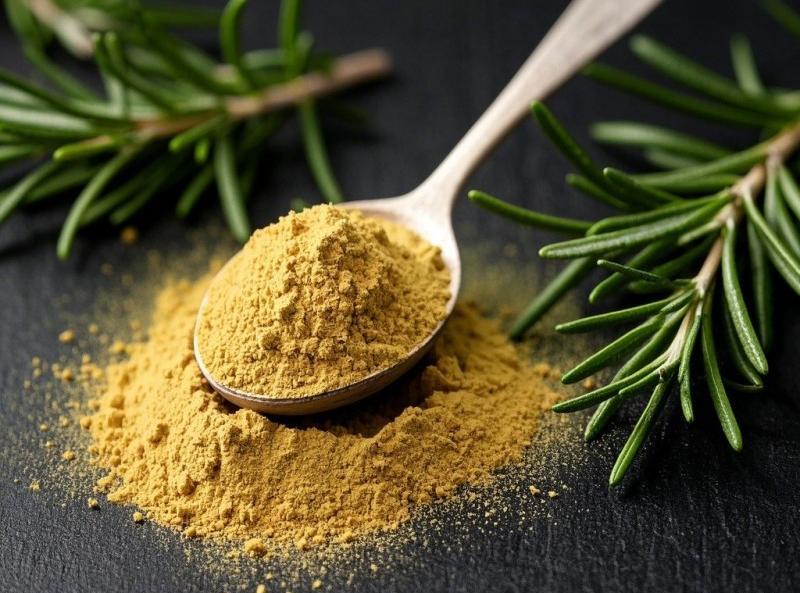
2 Extraction process of rosemary active ingredients
When extracting rosemary active ingredients, rosemary essential oil is generally extracted first, followed by extraction of carnosic acid, oleanolic acid and ursolic acid, and finally rosmarinic acid. Among them, rosemary essential oil is mainly extracted by distillation, extraction, supercritical fluid extraction and other methods. The extraction of rosemary essential oil by organic solvent extraction method has the characteristics of high content and good stability, but it is costly, time-consuming, and difficult to remove impurities. The distillation method is widely used for extracting rosemary essential oil, and has the advantages of being simple and practical, and low cost, but it is time-consuming.
Supercritical fluid extraction of rosemary essential oil has high content, excellent quality, and high activity, but it is more expensive, has high process requirements, and high equipment maintenance costs [19]. After the essential oil is extracted, the rosemary leaves are refluxed with an organic solvent, decolorized, boiled with water, centrifuged, precipitated, dried, etc., to obtain salvianic acid, oleanolic acid and ursolic acid. The above ingredients are mainly extracted using organic solvent extraction and supercritical fluid extraction. Supercritical fluid extraction is the preferred method because of its high-quality product composition and no solvent residue [20]. The main extraction process parameters for the active ingredients of rosemary are shown in Table 1.
3 Biological functions of rosemary active ingredients
3.1 Antibacterial function
The antibacterial function of rosemary is mainly determined by the activity of carnosic acid and rosmarinic acid. Rosemary active ingredients can inhibit the proliferation and growth of harmful bacteria such as Staphylococcus aureus, Pseudomonas aeruginosa and Candida albicans[25]. SACCO et al. [26] used the broth dilution method to evaluate the antibacterial activity of rosemary ethanol extract and found that the minimum bactericidal concentration of rosemary ethanol extract against Escherichia coli was 0.07 g/L and the minimum bactericidal concentration against Pseudomonas aeruginosa was 0.20 g/L. EKAMBARAM et al. [27] found that the minimum bacteriostatic concentration of rosemary extract against Staphylococcus aureus is 0.8 g/L. The main mechanism of the bacteriostatic function of rosemary extract is that it can inhibit the enzymatic activity in bacterial cells and altering the permeability of the cell membrane; rosemary extract can inhibit the expression of virulence factors on the surface membrane proteins of bacteria; rosemary extract can also inhibit the activity of hypoxia-inducible factor-prolyl hydroxylase-2 and activate the vascular endothelial growth factor pathway, thereby inhibiting the reproduction of harmful bacteria (Escherichia coli)[28].
3.2 Antioxidant function
The substances in rosemary extract that exert antioxidant function are mainly diterpenoid components. Wang Ying et al. [29] found that rosemary essential oil can effectively remove 1, 1-diphenyl-2-trinitrophenylhydrazine (DPPH), and its antioxidant effect is superior to 2, 6-di-tert-butyl-p-cresol (BHT), butylated hydroxyanisole (BHA), oregano essential oil, and wormwood essential oil. The IC50 values of the rosemary fat-soluble antioxidant for the scavenging of 2,2'-azobis(3-ethylbenzothiazoline-6-sulfonic acid) diammonium salt (ABTS+), the IC50 values for the scavenging of DPPH free radicals and hydroxyl radicals were 0.071, 0.051 and 0.287 g/L, respectively, and it has a good reducing power for iron [30]. When chicken is frozen for preservation, the addition of 1% rosemary extract can inhibit the production of microorganisms during preservation and inhibit lipid oxidation [31]. The main antioxidant mechanisms of rosemary extract are as follows: rosemary extract can change the fluidity of lipid membranes, scavenge free radicals, inhibit the spread of hydrophilic free radicals in bilayer membranes, and thus inhibit lipid oxidation; rosemary extract can inhibit the expression of active oxygen genes, reduce the production of malondialdehyde, and increase the activity of superoxide dismutase and glutathione peroxidase, to achieve an antioxidant effect [32-33].
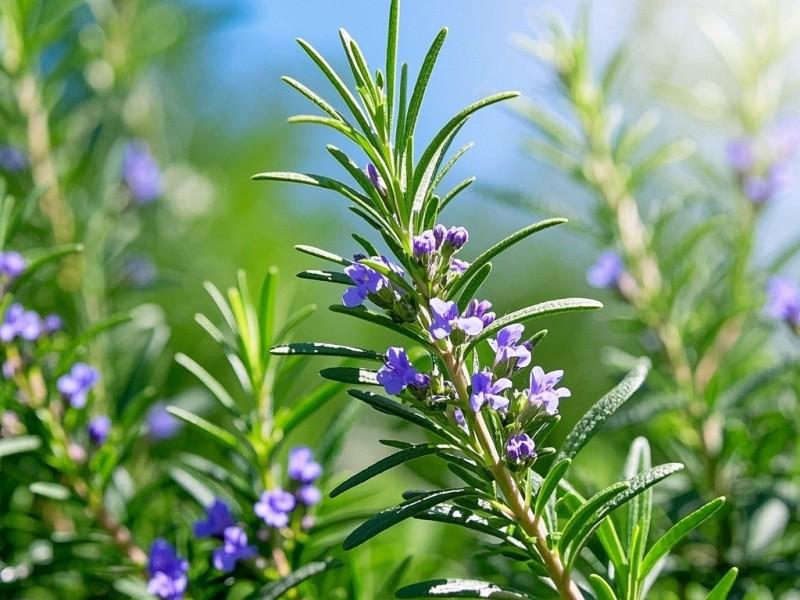
3.3 Anti-inflammatory function
Rosemary extract has the effect of treating respiratory tract inflammation [34]. Studies have found that the anti-inflammatory effect of rosemary extract is better than that of sage acid and carnosol alone, possibly because the phenols and acids in rosemary have a synergistic effect in terms of anti-inflammation [35]. Rosemary extract can inhibit the body's production of tumor necrosis factor-α, interleukin-6 and nitric oxide, and inhibit the expression of proteins related to the nuclear transcription factor (NF-κB)/NOD-like receptor heat shock domain-associated protein 3 (NLRP3) signaling pathway to improve the body's anti-inflammatory function [36].
4 Rosemary active ingredients in animal production
4.1 Application of rosemary active ingredients in poultry production
In poultry production, rosemary active ingredients can improve the immune and antioxidant functions of the body by reducing the inflammatory response in the intestine, thereby improving the production performance and meat quality of poultry. Wu Lifei et al. [37] added an appropriate amount of rosemary extract to AA broiler production and found that rosemary extract reduced the mortality rate of broilers, increased the activity of antioxidant enzymes in the body, increased the relative abundance of beneficial bacteria in the intestine, reduced the relative abundance of harmful bacteria, improved the intestinal morphology, and thus improved growth performance. The optimal addition level of rosemary extract is 500 mg/kg.
You Jiamin et al. [38] studied the effect of rosmarinic acid on the growth and inflammatory response of broilers challenged with C. Elegans. found that 80 mg/kg and 160 mg/kg rosmarinic acid significantly reduced the number of oocysts in the feces of broilers challenged with C. perfringens. The mortality rate of broilers in the 80 mg/kg rosmarinic acid group was significantly reduced by 35.60%, the 160 mg/kg rosemary acid group had a 50% increase in bursa index, and the 80 mg/kg rosemary acid group had a 32.70% decrease in tumor necrosis factor-α levels.
Chen Lu et al. [39] found that the combined addition of 15 mg/kg hesperidin and 30 mg/kg rosmarinic acid can significantly increase the average daily weight gain and average daily feed intake of broiler chickens, increase the breast muscle rate and slaughter rate, reduce muscle pH, drip loss and shear force, increase muscle superoxide dismutase activity, and lower the malondialdehyde level in the muscle, indicating that the combined use of hesperidin and rosmarinic acid can improve the growth performance of broiler chickens and improve the quality of chicken meat.
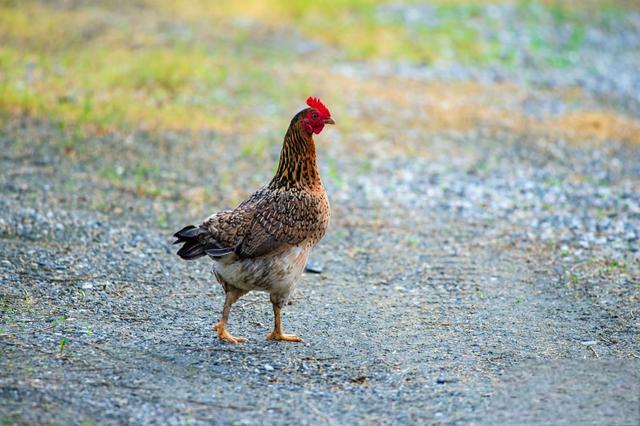
In laying hen production, adding the right amount of rosemary extract can improve the laying performance of laying hens and improve the quality of eggs. Fu Xiaoqin et al.[40] showed that 50 mg/kg rosemary extract tended to increase the egg production rate of green-shelled laying hens, but did not reach a significant level; 100, 200, and 400 mg/kg rosemary extract significantly increased the yolk color by 17.02%, 32.20%, 30.64%; 400 mg/kg rosemary extract can increase the crude protein content of eggs by 6.80%, which indicates that the appropriate amount of rosemary extract improves egg quality.
Yang Jiansheng et al. [41] studied the effect of rosemary herb powder on the egg production performance, egg quality and serum biochemical indicators of laying hens under high temperature conditions, found that 0.3% rosemary herb powder can significantly improve the egg production rate, egg weight, yolk color and albumin level in the serum of Jingfen No. 1 laying hens, indicating that rosemary can improve the effect of heat stress on the egg production performance and egg quality of Jingfen No. 1 laying hens. Wang Xiaohui et al. [42] found that 0.6% rosemary can reduce the expression of heat shock protein 70 (HSP70) genes in tissues such as the ovaries and uteri of laying hens, and increase the expression of lysozyme (LYZ) genes in ovarian and isthmus tissues, indicating that rosemary can alleviate the adverse effects of heat stress on the production performance of laying hens and extend the storage time of eggs.
4.2 Application of rosemary active ingredients in pig production
At present, research on the application of rosemary in pig production mainly focuses on its antioxidant function. Zhao Wenxuan et al. [43] studied the effects of hesperidin and rosmarinic acid on intestinal antioxidant, flora and barrier function in finishing pigs, found that hesperidin and rosmarinic acid increased the average daily weight gain of fattening pigs and reduced the feed conversion ratio; increased the activity of superoxide dismutase in the cecum and total antioxidant capacity, and increased the relative mRNA expression of nuclear factor E2-related factor and heme oxygenase-1; reduced the relative abundance of Proteus spp. significantly increased the relative abundance of Bacteroides and Lactobacillus; significantly increased the relative mRNA expression of occludin-1, tight junction protein-1, and mucin-2; significantly decreased the content of interleukin-1β and significantly increased the content of secretory immunoglobulin A.
Studies have shown that 300 mg/kg hesperidin + 20 mg/kg rosmarinic acid improves the health of fattening pigs [43]. A study by Tai Ruiqing [44] showed that rosmarinic acid can effectively improve the growth performance of finishing pigs, enhance immunity and antioxidant properties, regulate lipid metabolism by inhibiting fat synthesis and promoting fat decomposition. Chen Meijie [45] studied the effect of rosmarinic acid on the preservation of pig semen. On the 9th day of semen preservation, it was found that 40 μmol/L rosmarinic acid could maintain sperm motility, plasma membrane integrity and acrosome integrity at 66.47%, 63.31% and 73.77% respectively, indicating a good semen preservation effect. It also significantly improved the antioxidant capacity (T-AOC) and superoxide dismutase (SOD) activity of sperm, significantly reduced the malondialdehyde (MDA) content, significantly increased adenosine triphosphate (ATP) content, mitochondrial membrane potential and 3-phosphoglycerate dehydrogenase (GAPDH) activity. IRENE et al. [46] studied the effect of rosemary extract on pork quality and found that adding 1000 mg/kg rosemary extract to pork can effectively reduce the number of microorganisms in the pork, preserve the meat color better, and enhance the antioxidant properties of the meat.
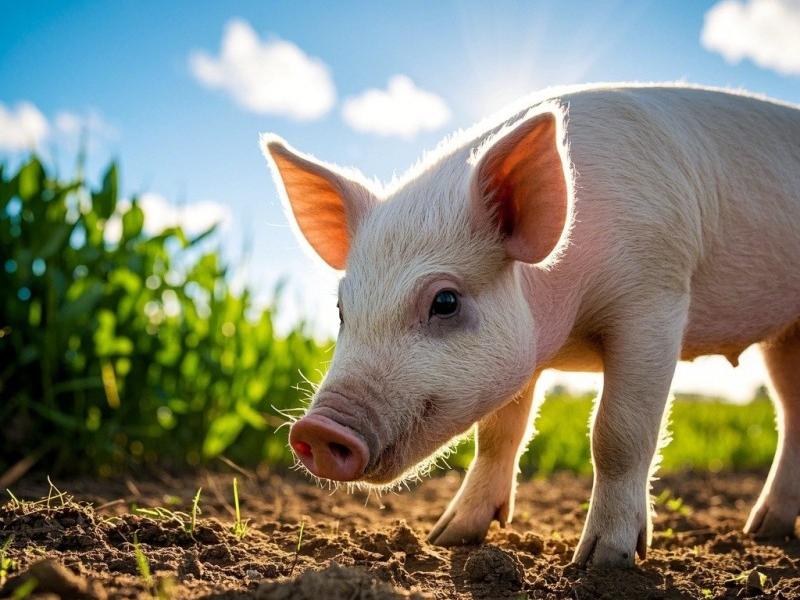
The above research results show that adding an appropriate amount of rosemary extract during pig farming and meat preservation can improve the antioxidant properties and antibacterial function of pigs, improve intestinal health, and thus improve pig growth performance and meat quality.
4.3 Application of rosemary active ingredients in ruminant production
At present, there is little research on the application of rosemary extract in ruminant production. Zhang Ziyang [47] studied the effect of rosemary extract on the production performance and serum indicators of dairy goats and found that a mixture consisting of 5% rosmarinic acid, 5% polyphenols and 1% caffeic acid can increase the milk production of dairy goats by 5.84%, increased the milk protein rate and total serum antioxidant capacity, lowered the serum malondialdehyde level, and increased the serum immunoglobulin A and immunoglobulin M levels, indicating that an appropriate amount of rosemary extract can improve the milk production performance, milk quality, antioxidant capacity and immune function of dairy goats.
In meat sheep farming, the addition of 600 mg/kg of carnosic acid and carnosol was found to be deposited in the meat, thereby reducing the number of microorganisms in the meat and enhancing the antioxidant properties of the meat [48]. Adding rosemary extract to ewe diets had no significant effect on milk yield and milk quality, but the flavonoids in rosemary can be deposited in milk and serum [49]. A study found that 1,200 mg/(head·d) rosemary extract could increase ewes' milk production, and also increase the levels of protein, fat and lactose in milk, and reduce the curd time [50]. Adding rosemary extract to the diet of dairy goats can increase the content of polyunsaturated fatty acids and C18:2 in milk and reduce the content of C14:0 [51]. The above research results are not consistent, but the general trend is that rosemary extract can increase milk production, improve milk quality, enhance antioxidant capacity and immunity.
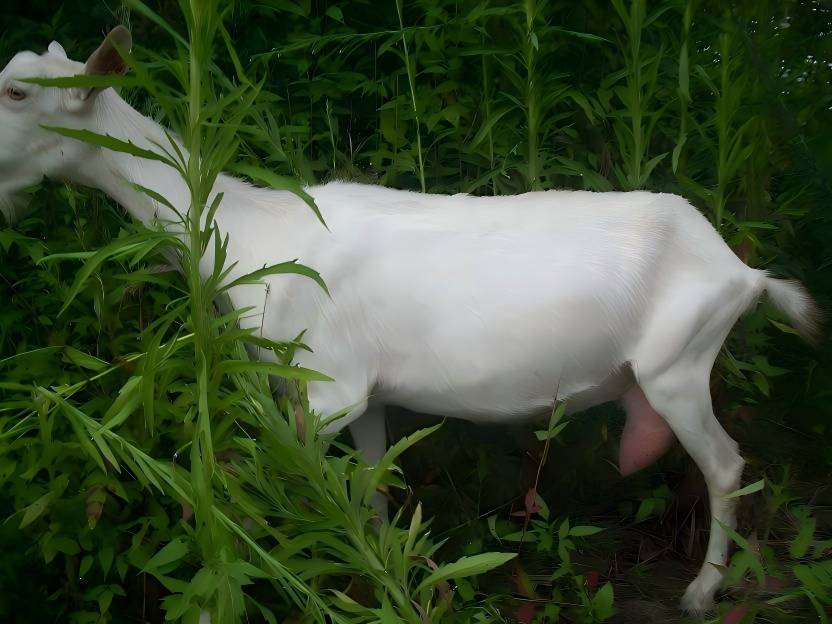
5 Outlook
Rosemary extract contains a variety of bioactive substances, including rosemary essential oil, rosmarinic acid, salvianolic acid, salvianol, oleanolic acid and ursolic acid. These active ingredients have a good effect in regulating immunity, anti-inflammation, antibacterial, anti-oxidation, regulating the abundance of intestinal flora, promoting growth, improving meat quality, have a good effect and have broad application prospects in animal breeding in Telugu. However, there have been few research studies on the application of rosemary extract in the production of pigs and ruminants. In the future, a large number of experiments will be needed to explore the effects of rosemary extract on the production performance and meat quality of pigs and ruminants. The mechanism of rosemary extract improving production performance and livestock product quality needs to be revealed. In the future, further research is also needed on the extraction process and production process of rosemary active ingredients to produce rosemary extract products with low cost, high activity and high purity.
References
[1] Zhang Yuan, Hu Zaijin. Seedling raising and planting techniques for Chinese medicinal herb rosemary [J]. Grassroots Agricultural Technology Extension, 2023, 11(5): 120-122.
[2] Xu Shude, Zheng Xin, Hu Haibo, et al. Mechanism of action of rosemary extract and its application in animal production [J]. Journal of Animal Nutrition, 2023, 35(6): 3401-3409.
[3] Wang Linyi, Wang Ding, Li Shaoyu, et al. Biological functions of rosemary and its application in animal production [J]. China Feed, 2022(21): 8-13.
[4] Guo, Pengfei. Optimization of the extraction process of antioxidant substances from rosemary leaves and research on their application characteristics [D]. Changsha: Central South University of Forestry and Technology, 2023.
[5] Shao, Yanxi. Antioxidant effect of fat-soluble rosemary extract on flavored noodle products [J]. Food Industry, 2023, 44(9): 147-150.
[6] Liu Yufang, Liu Fen, Song Yukun, et al. Effect of extraction method on the antibacterial and antioxidant activities of rosemary processing residue extract [J]. Economic Forestry Research, 2023, 41(2): 272-281.
[7] Duan Guangying, Peng Fang, Song Zehuo, et al. Biological functions of rosemary extract and its application in animal production [J]. Journal of Animal Nutrition, 2020, 32(2): 516-522.
[8] Wang Yan. Biological functions of rosmarinic acid and its application prospects in animal husbandry [J]. Guangdong Feed, 2013, 22(12): 31-34.
[9] Wang D. Effects of rosemary and Bacillus natto on the production performance, meat quality, antioxidant capacity, immune function and intestinal flora of broilers [D]. Zhengzhou: Henan Agricultural University, 2023.
[10] Tai RQ. Effects of rosmarinic acid on the antioxidant level and fat metabolism of finishing pigs [D]. Yangling: Northwest A&F University, 2023.
[11] Liu Shengnan, Ma Yunfang, Fan Liu Min, et al. Research progress on the active components and physiological functions of rosemary [J]. Processing of Agricultural Products, 2019 (13): 79-83.
[12] Ren Liping, Li Xianjia, Jin Shaoju. Separation and purification of total flavonoids from rosemary leaves by macroporous resin and study of antioxidant activity [J]. Chinese Condiments, 2017, 42(4): 69-73.
[13] Zhu Zhiyan, Tian Hao, Pan Jun, et al. Progress in the preparation and antioxidant and antibacterial activities of rosemary extract [J]. Food Industry Science and Technology, 2023, 44(12): 461-469.
[14] PENG Y, YUAN J, LIU F, et al. Determination of active components in rosemary by capillary electrophoresis with electrochemical detection [J]. J Pharmaceut Biomed, 2005, 39(3/4): 431-437.
[15] WANG X X, WANG P, DU H T, et al. Prediction of the active components and mechanism of Forsythia suspensa leaf against respiratory syncytial virus based on network pharmacology[J]. Evidence- Based Complementary and Alternative Medicine, 2022, 2022: 5643345.
[16] RATTANATHORN C, JAKKRIT J, VARINDA W, et al. Comparative study of callus culture and leaves of Thunbergia laurifolia for their bioactive constituents and the activation of AMPK and GLUT-dependent glucose uptake on rat skeletal muscle (L6) cells[J]. Journal of Food Processing and Preservation, 2021, 45(5): 15434.
[17] GROVER C, NICOLAS C, BEATRIZ S, et al. Untargeted metabolomics by using UHPLC-ESI-MS/MS of an extract obtained with ethyl lactate green solvent from Salvia rosmarinus[J]. Separations, 2022, 9(11): 327.
[18] ZHENG W, WANG S Y. Antioxidant activity and phenolic compounds in selected herbs[J]. J Agric Food Chem, 2001, 49(11):5165-5170.
[19] Wu Siyu, Tang Xing, Deng Yane, et al. Research progress on the extraction methods and activities of rosemary essential oil [J]. Guangdong Chemical Industry, 2021, 48(23): 93-95.
[20] Qu Liangliang, Duan Kaili, Wu Yanni, et al. Combined extraction of rosmarinic acid, carnosic acid and ursolic acid from rosemary [J]. Food Industry Science and Technology, 2019, 40(9): 208-212.
[21] Yan W F, Gao X H, Yang R X, et al. Optimization of the process for extracting rosemary essential oil by atmospheric distillation using response surface methodology [J]. Chinese Condiments, 2022, 47(11): 115-119, 124.
[22] Bi Jing, Ye Hesheng. Optimization of Supercritical CO2 Extraction of Rosemary Essential Oil by Response Surface Test [J]. Chinese Condiments, 2021, 46(6): 132-135.
[23] Luo Xiaofang, Chen Qiyan, Wang Zhai, et al. Ultrasonic crushing extraction process of rosmarinic acid from rosemary leaves and its anti-fat oxidation research [J]. China Oil and Fat, 2019, 44(5): 118-122.
[24] Li Linna, Yang Jiwei, Zhang Lifen, et al. Optimization of the process of extracting rosmarinic acid and carnosic acid from rosemary by the response surface method using a eutectic solvent [J]. Food Industry Technology, 2023, 44(16):218-227.
[25] DE OLIVEIRA J R, DE JESUS D, FIGUEIRA L W, et al. Biological activities of Rosmarinus oficinalis L. (rosemary) extract as analyzed in microorganisms and cells[J]. Experimental Biology and Medicine, 2017, 242(6): 625-634.
[26] SACCO C, BELLUMORI M, SANTOMAURO F, et al. An invitro evaluation of the antibacterial activity of the non-volatile phenolic fraction for rosemary leaves[J]. Natural Product Research, 2014, 29(16): 1537-1544.
[27] EKAMBARAM S P, PERUMAL S S, BALAKRISHNAN A, et al. Antibacterial synergy between rosmarinic acid and antibiotics against methicillin-resistant Staphylococcus aureus[J]. Journal of Intercultural Ethnopharmacology, 2016, 5(4): 358-363.
[28] Zeng Fajiao, Zhou Xiaoling, Wang Bin, et al. Research progress on the antibacterial effect of rosemary extract and its active ingredients [J]. Hunan Agricultural Sciences, 2023(7): 110-114.
[29] Wang Y, Wang XY, Li HF, et al. Preliminary study on the in vitro antioxidant and antibacterial effects of oregano essential oil, wormwood essential oil and rosemary essential oil [J]. Feed Research, 2023, 46(17): 82-86.
[30] Wang Ying, Zhu Xinyan, Zeng Xianghui, et al. Optimization of the extraction process and antioxidant activity of rosemary's fat-soluble antioxidant ingredients by response surface methodology [J]. China Food Additives, 2022, 33(11): 148-154.
[31] GAO B Z J. Effect of rosemary extract on microbial growth, pH, color, and lipid oxidation in cold plasma-processed ground chicken patties[J]. Innovative Food Science & Emerging Technologies, 2019, 57: 102168.
[32] KABUBII Z N, MBARIA J M, MATHIU M P, et al. Evaluation of seasonal variation, effect of extraction solvent on phytochemicals and antioxidant activity on Rosmarinus oficinalis grown in different agro- ecological zones of Kiambu County, Kenya[J]. CABI Agriculture and Bioscience, 2023, 4(1): 141.
[33] MEHDI A, FARNAZ A, ELIAS S G, et al. Green synthesis of spermine coated iron nanoparticles and its effect on biochemical properties of Rosmarinus oficinalis[J]. Scientific Reports, 2023, 13(1): 775.
[34] ZANELLA C A, TREICHEL H, CANSIAN R L, et al. The effects of acute administration of the hydroalcoholic extract of rosemary (Rosmarinus oficinalis L.) (Lamiaceae) in animal models of memory [J]. Brazilian J Pharm Sci, 2012, 48(3): 389-397.
[35] KUO C F, SU J D, CHIU C H, et al. Anti-inflammatory effects of supercritical carbon dioxide extract and its isolated carnosic acid from Rosmarinus oficinalis leaves[J]. J Agric Food Chem, 2011, 59(8): 3674-3685.
[36] Wang Lihuan, Li Yijie, Yang Huan, et al. Mechanism of rosmarinic acid regulating the NF-κB/NLRP3 signaling pathway to alleviate acute gouty arthritis in rats [J/OL]. Chinese Journal of Immunology: 1-11 [2024-01-13]. http://kns.cnki.net/kcms/detail/22.1126.R.20230731.16 38.002.html.
[37] Wu Lifei, Gao Wei, Zhao Pengyu, et al. Effects of rosemary extract on growth performance, serum antioxidant indicators, intestinal morphology and intestinal flora of broilers [J]. Journal of Animal Nutrition, 2023, 35(8): 5036-5048.
[38] You Jiamin, Yang Qianzhi, Gong Jiatai, et al. Effect of rosmarinic acid on growth performance, immune function and inflammatory response in broilers challenged with C. jejuni[J]. Journal of Animal Nutrition, 2023, 35(9): 5696-5707.
[39] Chen Lu, Zhao Daoyuan, Wu Jianmin, et al. Effects of hesperidin and rosmarinic acid on growth performance, meat quality and antioxidant function of broiler chickens [J]. Journal of Nanjing Agricultural University, 2023, 46(4):756-763.
[40] Fu Xiaoqin, Fan Qing, Gou Dan, et al. Effects of rosemary extract on the production performance, egg quality and antioxidant function of black-feathered green-shelled laying hens [J]. Journal of Animal Nutrition, 2022, 34(1): 329-339.
[41] Yang Jiansheng, Lin Yuxin, An Tingting, et al. Effects of rosemary herb powder on egg production performance, egg quality and serum indicators of laying hens at high temperatures [J]. China Feed, 2016(19):9-11,25.
[42] Wang Xiaohui, Xin Shijie, Zou Wenbin, et al. Effect of a combination of rosemary, vitamin E, vitamin C and soybean oil added to the diet on the gene expression of HSP70 and LYZ in different tissues of laying hens during the heat period [J]. Chinese Journal of Veterinary Medicine, 2019, 39(4): 767-773.
[43] Zhao Wenxuan, Wu Jianmin, Dang Miaomiao, et al. Effects of a combination of hesperidin and rosmarinic acid on the morphology, antioxidant function, bacterial structure and barrier function of the cecum in finishing pigs [J]. Acta Microbiologica Sinica, 2023, 63(11): 4356-4371.
[44] TAI Ruiqing. Effects of rosemary acid on antioxidant levels and fat metabolism in finishing pigs [D]. Yangling: Northwest A&F University, 2023.
[45] CHEN Meijie. Study on the effect of salvianolic acid and rosmarinic acid on the room temperature preservation of pig semen [D]. Yangling: Northwest A&F University, 2019.
[46] IRENE P, MARIELLA S A, MACARENA E, et al. Effects of dietary rosemary extract supplementation on pork quality of chato murciano breed during storage[J]. Animals, 2021, 11(8): 2295.
[47] Zhang Ziyang. Effects of rosemary extract on milk production performance and blood indicators of dairy goats [D]. Changsha: Hunan Agricultural University, 2023.
[48] ORTUNO J, SERRANO R, BANÓN S, et al. Antioxidant and antimicrobial effects of dietary supplementation with rosemary diterpenes (carnosic acid and carnosol) vs vitamin E on lamb meat packed under protective atmosphere[J]. Meat Sci, 2015, 110: 62-69.
[49] JORDÁN M J, MONINO M I, MARTÍNEZ C, et al. Introduction of distillate rosemary leaves into the diet of the Murciano-Granadina goat: Transfer of polyphenolic compounds to goats' milk and the plasma of suckling goat kids[J]. J Agric Food Chem, 2010, 58(14): 8265-8270.
[50] CHIOFALO B, RIOLO E B, FASCIANA G, et al. Organic management of dietary rosemary extract in dairy sheep: Effects on milk quality and clotting properties[J]. Vet Res Commun, 2010, 34(Suppl 1):197-201.
[51] BOUTOIAL K, FERRANDINI E, ROVIRA S, et al. Effect of feeding goats with rosemary (Rosmarinus oficinalis spp.) by-product on milk and cheese properties[J]. Small Rumin Res, 2012, 112(1/3):147-153.


 English
English French
French Spanish
Spanish Russian
Russian Korean
Korean Japanese
Japanese